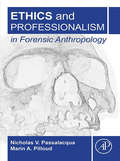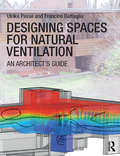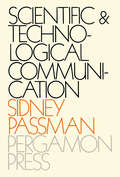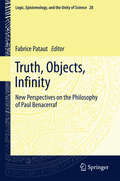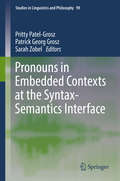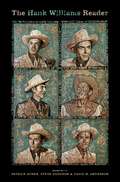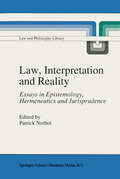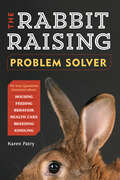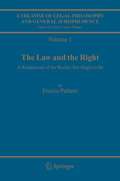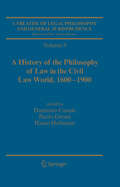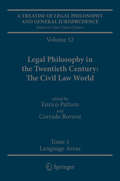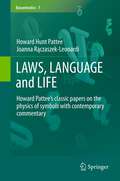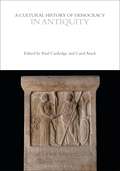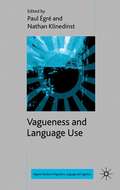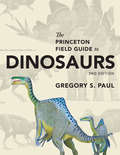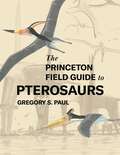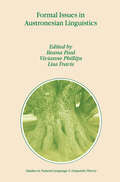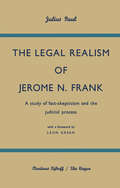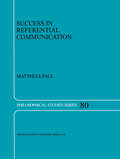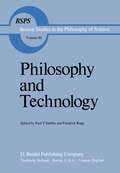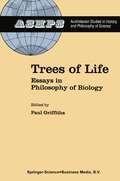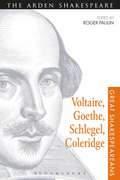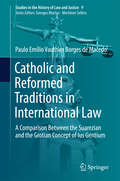- Table View
- List View
Ethics and Professionalism in Forensic Anthropology
by Nicholas V. Passalacqua Marin A. PilloudForensic anthropologists are confronted with ethical issues as part of their education, research, teaching, professional development, and casework. Despite the many ethical challenges that may impact forensic anthropologists, discourse and training in ethics are limited. The goal for Ethics and Professionalism in Forensic Anthropology is to outline the current state of ethics within the field and to start a discussion about the ethics, professionalism, and legal concerns associated with the practice of forensic anthropology. This volume addresses: The need for professional ethicsCurrent ethical guidelines applicable to forensic anthropologists and their means of enforcementDifferent approaches to professionalism within the context of forensic anthropology, including issues of scientific integrity, qualifications, accreditation and quality assuranceThe use of human subjects and human remains in forensic anthropology researchEthical and legal issues surrounding forensic anthropological casework, including: analytical notes, case reports, peer review, incidental findings, and testimonyHarassment and discrimination in science, anthropology, and forensic anthropology
Designing Spaces for Natural Ventilation: An Architect's Guide
by Ulrike Passe Francine BattagliaBuildings can breathe naturally, without the use of mechanical systems, if you design the spaces properly. This accessible and thorough guide shows you how in more than 260 color diagrams and photographs illustrating case studies and CFD simulations. You can achieve truly natural ventilation, by considering the building's structure, envelope, energy use, and form, as well as giving the occupants thermal comfort and healthy indoor air. By using scientific and architectural visualization tools included here, you can develop ventilation strategies without an engineering background. Handy sections that summarize the science, explain rules of thumb, and detail the latest research in thermal and fluid dynamics will keep your designs sustainable, energy efficient, and up-to-date.
Designing Spaces for Natural Ventilation: An Architect's Guide
by Ulrike Passe Francine BattagliaBuildings can breathe naturally, without the use of mechanical systems, if you design the spaces properly. This accessible and thorough guide shows you how in more than 260 color diagrams and photographs illustrating case studies and CFD simulations. You can achieve truly natural ventilation, by considering the building's structure, envelope, energy use, and form, as well as giving the occupants thermal comfort and healthy indoor air. By using scientific and architectural visualization tools included here, you can develop ventilation strategies without an engineering background. Handy sections that summarize the science, explain rules of thumb, and detail the latest research in thermal and fluid dynamics will keep your designs sustainable, energy efficient, and up-to-date.
Scientific and Technological Communication
by Sidney PassmanScientific and Technological Communication deals with the fundamental aspects of the elements and media of scientific and technological communication, with emphasis on the critical issues involving them as well as the opportunities and techniques for exploiting them. Topics covered include informal information exchange; specialized information and analysis centers; mechanization and information handling; and international aspects of scientific and technical communication. This book is comprised of nine chapters and begins with an overview of the scientific communication process, its evolution, and its elements, as well as the importance of the scientific literature to the integrity, correctness, and viability of this process. The following chapters explore the social role of the scientific literature in establishing priority of effort with respect to the research and engineering process; primary and secondary literature on scientific and technological communication, including scientific journals, monographs, and technical reports; informal information exchange; and specialized information and analysis centers. The final chapter is devoted to the international aspects of scientific and technical communication. This monograph will be a useful resource for scientific and technical practitioners, as well as users, generators, and managers of communication systems in private and government sectors.
Truth, Objects, Infinity: New Perspectives on the Philosophy of Paul Benacerraf (Logic, Epistemology, and the Unity of Science #28)
by Fabrice PatautThis volume features essays about and by Paul Benacerraf, whose ideas have circulated in the philosophical community since the early nineteen sixties, shaping key areas in the philosophy of mathematics, the philosophy of language, the philosophy of logic, and epistemology. The book started as a workshop held in Paris at the Collège de France in May 2012 with the participation of Paul Benacerraf. The introduction addresses the methodological point of the legitimate use of so-called “Princess Margaret Premises” in drawing philosophical conclusions from Gödel’s first incompleteness theorem. The book is then divided into three sections. The first is devoted to an assessment of the improved version of the original dilemma of “Mathematical Truth” due to Hartry Field: the challenge to the platonist is now to explain the reliability of our mathematical beliefs given the very subject matter of mathematics, either pure or applied. The second addresses the issue of the ontological status of numbers: Frege’s logicism, fictionalism, structuralism, and Bourbaki’s theory of structures are called up for an appraisal of Benacerraf’s negative conclusions of “What Numbers Could Not Be.” The third is devoted to supertasks and bears witness to the unique standing of Benacerraf’s first publication: “Tasks, Super-Tasks, and Modern Eleatics” in debates on Zeno’s paradox and associated paradoxes, infinitary mathematics, and constructivism and finitism in the philosophy of mathematics.Two yet unpublished essays by Benacerraf have been included in the volume: an early version of “Mathematical Truth” from 1968 and an essay on “What Numbers Could Not Be” from the mid 1970’s. A complete chronological bibliography of Benacerraf’s work to 2016 is provided.Essays by Jody Azzouni, Paul Benacerraf, Justin Clarke-Doane, Sébastien Gandon, Brice Halimi, Jon Pérez Laraudogoitia, Mary Leng, Antonio León-Sánchez and Ana C. León-Mejía, Marco Panza, Fabrice Pataut, Philippe de Rouilhan, Andrea Sereni, and Stewart Shapiro.
Pronouns in Embedded Contexts at the Syntax-Semantics Interface (Studies in Linguistics and Philosophy #99)
by Pritty Patel-Grosz Patrick Georg Grosz Sarah ZobelThis volume presents studies on pronouns in embedded contexts, and offers fundamental insights into this central area of research. Much of the recent research on pronouns has shown that embedded environments, such as clausal complements of attitude predicates, provide a window into the nature of pronouns. Pronouns in such environments not only exhibit familiar distinctions such as that between bound and referential pronouns; if they refer to the attitude holder, they also participate in a broader range of phenomena, e.g., distinguishing between a de se reading (involving a conscious self-directed belief) and a de re reading (involving an accidental belief about oneself). Topics covered include: the semantics of attitude reports that contain pronominal elements, the semantics of pronominal features and their connection to indexicality, new insights in the connection of pronominal typology and logophoricity or anti-logophoricity, and finally, the localization of embedded pronouns within a bigger picture involving the nature of perspective and the analysis of quasi-pronominal phenomena such as sequence of tense.
The Hank Williams Reader (Readers on American Musicians)
by Patrick Huber, Steve Goodson, and David M. AndersonWhen Hank Williams died on New Year's Day 1953 at the age of twenty-nine, his passing appeared to bring an abrupt end to a saga of rags-to-riches success and anguished self-destruction. As it turned out, however, an equally gripping story was only just beginning, as Williams's meteoric rise to stardom, extraordinary musical achievements, turbulent personal life, and mysterious death all combined to make him an endlessly intriguing historical figure. For more than sixty years, an ever-lengthening parade of journalists, family and friends, musical contemporaries, biographers, historians and scholars, ordinary fans, and novelists have attempted to capture in words the man, the artist, and the legend. The Hank Williams Reader, the first book of its kind devoted to this giant of American music, collects more than sixty of the most compelling, insightful, and historically significant of these writings. Among them are many pieces that have never been reprinted or that are published here for the first time. The selections cover a broad assortment of themes and perspectives, ranging from heartfelt reminiscences by Williams's relatives and shocking tabloid exposés to thoughtful meditations by fellow artists and penetrating essays by prominent scholars and critics. Over time, writers have sought to explain Williams in a variety of ways, and in tracing these shifting interpretations, this anthology chronicles his cultural transfiguration from star-crossed hillbilly singer-songwriter to enduring American icon. The Hank Williams Reader also features a lengthy interpretive introduction and the most extensive bibliography of Williams-related writings ever published.
Law, Interpretation and Reality: Essays in Epistemology, Hermeneutics and Jurisprudence (Law and Philosophy Library #11)
by PatrickNerhotPATRICKNERHOT Since the two operations overlap each other so much, speaking about fact and interpretation in legal science separately would undoubtedly be highly artificial. To speak about fact in law already brings in the operation we call interpretation. EquaHy, to speak about interpretation is to deal with the method of identifying reality and therefore, in large part, to enter the area of the question of fact. By way of example, Bemard Jackson's text, which we have placed in section 11 of the first part of this volume, could no doubt just as weH have found a horne in section I. This work is aimed at analyzing this interpretation of the operation of identifying fact on the one hand and identifying the meaning of a text on the other. All philosophies of law recognize themselves in the analysis they propose for this interpretation, and we too shall seek in this volume to fumish a few elements of use for this analysis. We wish however to make it clear that our endeavour is addressed not only to legal philosophers: the nature of the interpretive act in legal science is a matter of interest to the legal practitioner too. He will find in these pages, we believe, elements that will serve hirn in rcflcction on his daily work.
The Rabbit-Raising Problem Solver: Your Questions Answered about Housing, Feeding, Behavior, Health Care, Breeding, and Kindling
by Karen PatryA practical Q&A resource for every rabbit raiser, whether they raise their animals as pets, for meat, or for fiber.
A Treatise of Legal Philosophy and General Jurisprudence: Volume 1:The Law and The Right, Volume 2: Foundations of Law, Volume 3: Legal Institutions and the Sources of Law, Volume 4: Scienta Juris, Legal Doctrine as Knowledge of Law and as a Source of Law, Volume 5: Legal Reasoning, A Cognitive Approach to the Law
by Enrico PattaroThis paperback edition of the first of the twelve volumes of A Treatises of Legal Philosophy and General Jurisprudence, serves as an introduction to the first-ever multivolume treatment of all important issues in legal philosophy and general jurisprudence, consisting of a five-volume theoretical part and a six-volume historical part. The theoretical part covers the main topics of contemporary debate. The historical volumes trace the development of legal thought from ancient Greek times through the twentieth century. All volumes are edited by the renowned theorist Enrico Pattaro.
A Treatise of Legal Philosophy and General Jurisprudence: Vol. 9: A History of the Philosophy of Law in the Civil Law World, 1600-1900; Vol. 10: The Philosophers' Philosophy of Law from the Seventeenth Century to Our Days.
by Enrico PattaroTO VOLUMES 9 AND 10 OF THE TREATISE I am happy to present here the third batch of volumes for the Treatise project: This is the batch consisting of Volumes 9 and 10, namely, A History of the P- losophy of Law in the Civil Law World, 1600–1900, edited by Damiano Canale, Paolo Grossi, and Hasso Hofmann, and The Philosophers’ Philosophy of Law from the Seventeenth Century to Our Days, by Patrick Riley. Three v- umes will follow: Two are devoted to the philosophy of law in the 20th c- tury, and the third one will be the index for the entire Treatise, which will 1 therefore ultimately comprise thirteen volumes. This Volume 9 runs parallel to Volume 8, A History of the Philosophy of Law in the Common Law World, 1600–1900, by Michael Lobban, published in 2007. Volume 10, for its part, takes up where Volume 6 left off: which appeared under the title A History of the Philosophy of Law from the Ancient Greeks to the Scholastics (edited by Fred Miller Jr. in association with Carrie-Ann Biondi, likewise published in 2007), and which is mainly a history of the p- losophers’ philosophy of law (let us refer to this philosophy as A).
A Treatise of Legal Philosophy and General Jurisprudence: Volume 12 Legal Philosophy in the Twentieth Century: The Civil Law World, Tome 1: Language Areas, Tome 2: Main Orientations and Topics
by Enrico Pattaro Corrado RoversiA Treatise of Legal Philosophy and General Jurisprudence is the first-ever multivolume treatment of the issues in legal philosophy and general jurisprudence, from both a theoretical and a historical perspective. The work is aimed at jurists as well as legal and practical philosophers. Edited by the renowned theorist Enrico Pattaro and his team, this book is a classical reference work that would be of great interest to legal and practical philosophers as well as to jurists and legal scholar at all levels. The work is divided in two parts. The theoretical part (published in 2005), consisting of five volumes, covers the main topics of the contemporary debate; the historical part, consisting of six volumes (Volumes 6-8 published in 2007; Volumes 9 and 10, published in 2009; Volume 11 published in 2011 and Volume 12 forthcoming in 2016), accounts for the development of legal thought from ancient Greek times through the twentieth century. Volume 12 Legal Philosophy in the Twentieth Century: The Civil Law WorldVolume 12 of A Treatise of Legal Philosophy and General Jurisprudence, titled Legal Philosophy in the Twentieth Century: The Civil-Law World, functions as a complement to Gerald Postema’s volume 11 (titled Legal Philosophy in the Twentieth Century: The Common Law World), and it offers the first comprehensive account of the complex development that legal philosophy has undergone in continental Europe and Latin America since 1900. In this volume, leading international scholars from the different language areas making up the civil-law world give an account of the way legal philosophy has evolved in these areas in the 20th century, the outcome being an overall mosaic of civil-law legal philosophy in this arc of time. Further, specialists in the field describe the development that legal philosophy has undergone in the 20th century by focusing on three of its main subjects—namely, legal positivism, natural-law theory, and the theory of legal reasoning—and discussing the different conceptions that have been put forward under these labels. The layout of the volume is meant to frame historical analysis with a view to the contemporary theoretical debate, thus completing the Treatise in keeping with its overall methodological aim, namely, that of combining history and theory as a necessary means by which to provide a comprehensive account of jurisprudential thinking.
LAWS, LANGUAGE and LIFE: Howard Pattee’s classic papers on the physics of symbols with contemporary commentary (Biosemiotics #7)
by Howard Hunt Pattee Joanna Rączaszek-LeonardiHoward Pattee is a physicist who for many years has taken his own path in studying the physics of symbols, which is now a foundation for biosemiotics. By extending von Neumann’s logical requirements for self-replication, to the physical requirements of symbolic instruction at the molecular level, he concludes that a form of quantum measurement is necessary for life. He explains why all non-dynamic symbolic and informational controls act as special (allosteric) constraints on dynamical systems. Pattee also points out that symbols do not exist in isolation but in coordinated symbol systems we call languages. Such insights turn out to be necessary to situate biosemiotics as an objective scientific endeavor. By proposing a way to relate quiescent symbolic constraints to dynamics, Pattee’s work builds a bridge between physical, biological, and psychological models that are based on dynamical systems theory. Pattee’s work awakes new interest in cognitive scientists, where his recognition of the necessary separation—the epistemic cut—between the subject and object provides a basis for a complementary third way of relating the purely symbolic, computational models of cognition and the purely dynamic, non-representational models. This selection of Pattee’s papers also addresses several other fields, including hierarchy theory, artificial life, self-organization, complexity theory, and the complementary epistemologies of the physical and biological sciences.
A Cultural History of Democracy in Antiquity (The Cultural Histories Series)
by Paul Cartledge and Carol AtackThis volume surveys democracy broadly as a cultural phenomenon operating in different ways across a very wide range of ancient societies throughout Antiquity. It examines the experiences of those living in democratic communities and considers how ancient practices of democracy differ from our own.The origins of democracy can be traced in a general way to the earliest civilizations, beginning with the early urban societies of the Middle East, and can be seen in cities and communities across the Mediterranean world and Asia. In classical Athens, male citizens enjoyed full participation in the political life of the city and a flourishing democratic culture, as explored in detail in this volume. In other times and places democratic features were absent from the formal structures of regimes, but could still be found in the participatory structures of local social institutions.Each chapter takes a different theme as its focus: sovereignty; liberty and the rule of law; the “common good”; economic and social democracy; religion and the principles of political obligation; citizenship and gender; ethnicity, race, and nationalism; democratic crises, revolutions, and civil resistance; international relations; and beyond the polis. These ten different approaches to democracy in Antiquity add up to an extensive, synoptic coverage of the subject.
Vagueness and Language Use (Palgrave Studies in Pragmatics, Language and Cognition)
by Paul Égré & Nathan KlinedinstThis volume brings together twelve papers by linguists and philosophers contributing novel empirical and formal considerations to theorizing about vagueness. Three main issues are addressed: gradable expressions and comparison, the semantics of degree adverbs and intensifiers (such as 'clearly'), and ways of evading the sorites paradox.
The Princeton Field Guide to Dinosaurs: Second Edition
by Gregory S. PaulThe best-selling Princeton Field Guide to Dinosaurs remains the must-have book for anyone who loves dinosaurs, from amateur enthusiasts to professional paleontologists. Now extensively revised and expanded, this dazzlingly illustrated large-format edition features some 100 new dinosaur species and 200 new and updated illustrations, bringing readers up to the minute on the latest discoveries and research that are radically transforming what we know about dinosaurs and their world.Written and illustrated by acclaimed dinosaur expert Gregory Paul, this stunningly beautiful book includes detailed species accounts of all the major dinosaur groups as well as nearly 700 color and black-and-white images—skeletal drawings, "life" studies, scenic views, and other illustrations that depict the full range of dinosaurs, from small feathered creatures to whale-sized supersauropods. Paul's extensively revised introduction delves into dinosaur history and biology, the extinction of nonavian dinosaurs, the origin of birds, and the history of dinosaur paleontology, as well as giving a taste of what it might be like to travel back in time to the era when dinosaurs roamed the earth.Now extensively revised and expandedCovers nearly 750 dinosaur species, including scores of newly discovered onesProvides startling new perspectives on the famed Brontosaurus and TyrannosaurusFeatures nearly 700 color and black-and-white drawings and figures, including life studies, scenic views, and skull and muscle drawingsIncludes color paleo-distribution maps and a color time lineDescribes anatomy, physiology, locomotion, reproduction, and growth of dinosaurs, as well as the origin of birds and the extinction of nonavian dinosaurs
The Princeton Field Guide to Pterosaurs (Princeton Field Guides #155)
by Gregory S. PaulThe most up-to-date and authoritative illustrated guide to the marvelous flying reptiles that dominated the skies of the Mesozoic for 160 million yearsOnce seen by some as evolutionary dead-enders, pterosaurs were vigorous winged reptiles capable of thriving in an array of habitats and climates, including polar winters. The Princeton Field Guide to Pterosaurs transforms our understanding of these great Mesozoic archosaurs of the air. This incredible guide covers 115 pterosaur species and features stunning illustrations of pterosaurs ranging in size from swallows to small sailplanes, some with enormous, bizarre head crests and elongated beaks. It discusses the history of pterosaurs through 160 million years of the Mesozoic—including their anatomy, physiology, locomotion, reproduction, growth, and extinction—and even gives a taste of what it might be like to travel back to the Mesozoic. This one-of-a-kind guide also challenges the common image of big pterosaurs as ultralights that only soared, showing how these spectacular creatures could be powerful flappers as heavy as bears.Features detailed species accounts of 115 different kinds of pterosaurs, with the latest size and mass estimatesWritten and illustrated by the acclaimed researcher and artist who helped to redefine the anatomy and flight performance of pterosaursCovers everything from pterosaur biology to the colorful history of pterosaur paleontologyIncludes dozens of original skeletal drawings and full-color life studies
Formal Issues in Austronesian Linguistics (Studies in Natural Language and Linguistic Theory #49)
by I. Paul V. Phillips Lisa TravisAustronesian languages have long raised interesting questions for generative theories of syntax and morphology. The papers in this volume encompass some of these traditional questions and place them in newer theoretical contexts. Some of the papers also address new issues which add to our understanding of members of this language family on one side and the nature of linguistic theories on the other. There are three broad issues that re-occur throughout the volume - the role and analysis of verbal morphology, the nature of the subject or the topic in these languages, and the interaction of syntax and specificity. The papers in this volume show that as formal theories become more precise, a wider range of language data can be captured, and as the inventory of language data grows, the accuracy of formal linguistic theories improves.
The Legal Realism of Jerome N. Frank: A Study of Fact-Skepticism and the Judicial Process
by Julius PaulBetween the Levite at the gate and the judicial systems of our day is a long journey in courthouse government, but its basic structure remains the same - law, judge and process. Of the three, process is the most unstable - procedure and facts. Of the two, facts are the most intractable. While most of the law in books may seem to center about abstract theories, doctrines, princi ples, and rules, the truth is that most of it is designed in some way to escape the painful examination of the facts which bring parties in a particular case to court. Frequently the emphasis is on the rule of law as it is with respect to the negotiable instru ment which forbids inquiry behind its face; sometimes the empha sis is on men as in the case of the wide discretion given a judge or administrator; sometimes on the process, as in pleading to a refined issue, summary judgment, pre-trial conference, or jury trial designed to impose the dirty work of fact finding on laymen. The minds of the men of law never cease to labor at im proving process in the hope that some less painful, more trustworthy and if possible automatic method can be found to lay open or force litigants to disclose what lies inside their quarrel, so that law can be administered with dispatch and de cisiveness in the hope that truth and justice will be served.
Success in Referential Communication (Philosophical Studies Series #80)
by M. PaulOne of the most basic themes in the philosophy of language is referential uptake, viz., the question of what counts as properly `understanding' a referring act in communication. In this inquiry, the particular line pursued goes back to Strawson's work on re-identification, but the immediate influence is that of Gareth Evans. It is argued that traditional and recent proposals fail to account for success in referential communication. A novel account is developed, resembling Evans' account in combining an external success condition with a Fregean one. But, in contrast to Evans, greater emphasis is placed on the action-enabling side of communication. Further topics discussed include the role of mental states in accounting for communication, the impact of re-identification on the understanding of referring acts, and Donnellan's referential/attributive distinction. Readership: Philosophers, cognitive scientists and semanticists.
Philosophy and Technology (Boston Studies in the Philosophy and History of Science #80)
by Paul T. Durbin and Friedrich RappOnly recently has the phenomenon of technology become an object of in terest for philosophers. The first attempts at a philosophy of technology date back scarcely a hundred years - a span of time extremely short when com pared with the antiquity of philosophical reflections on nature, science, and society. Over that hundred-year span, speculative, critical, and empiricist approaches of various sorts have been put forward. Nevertheless, even now there remains a broad gap between the importance of technology in the real world and the sparse number of philosophical works dedicated to the under standing of modern technology. As a result of the complex structure of modern technology, it can be dealt with in very different ways. These range from metaphysical exposition to efforts aimed at political consensus. Quite naturally, within such a broad range, certain national accents can be discovered-; they are shaped by a com mon language, accepted philosophical traditions, and concrete problems requiring consideration. Even so, the worldwide impact of technology, its penetration into all spheres of individual, social, and cultural life, together with the urgency of the problems raised in this context - all these demand a joint philosophical discussion that transcends the barriers of language and cultural differences. The papers printed here are intended to exemplify such an effort at culture-transcending philosophical discussion.
Trees of Life: Essays in Philosophy of Biology (Studies in History and Philosophy of Science #11)
by PaulGriffithsAustralia and New Zealand boast an active community of scholars working in the field of history, philosophy and social studies of science. • Australasian Studies in History and Philosophy of Science' aims to provide a distinctive publication outlet for their work. Each volume comprises a group of essays on a connected theme, edited by an Australian or a New Zealander with special expertise in that particular area .. In each volume, a majority of the contributors is from Australia or New Zealand. O;mtributions from elsewhere are by no means ruled out, however, and are indeed actively encouraged wherever appropriate to the balance of the volume in question. Earlier volumes in the series have been welcomed for significantly advancing the discussion of the topics they have dealt with. The present volume will I believe be greeted equally enthusiastically by readers in many parts of the world. R. W. Home General Editor Australasian Studies in History and Philosophy of Science TABLE OF CONTENTS v FOREWORD PAUL GRIFFITHS / Introduction 1 SECTION ONE: BEYOND NATURAL SELECTION ELLIOTI SOBER / Models of Cultural Evolution 17 KIM STERELNY / Punctuated Equilibrium and Macroevolution 41 ROBIN CRAW / Margins of Cladistics: Identity, Difference and Place in the Emergence of Phylogenetic Systematics 1864-1975 65 SECTION TWO: CENTRAL CONCEPTS OF EVOLUTIONARY THEORY PAUL GRIFFITHS / Adaptive Explanation and the Concept of a Vestige 111 TIMOTHY SHANAHAN / Selection, Drift and the Aims of Evolutionary Theory 133 SECTION THREE: THE DEVELOPMENTAL SYSTEMS APPROACH
Voltaire, Goethe, Schlegel, Coleridge: Great Shakespeareans: Volume III (Great Shakespeareans)
by Roger PaulinGreat Shakespeareans offers a systematic account of those figures who have had the greatest influence on the interpretation, understanding and cultural reception of Shakespeare, both nationally and internationally. In this volume, leading scholars assess the contribution of Voltaire, Goethe, Schlegel and Coleridge to the afterlife and reception of Shakespeare and his plays. Each substantial contribution assesses the double impact of Shakespeare on the figure covered and of the figure on the understanding, interpretation and appreciation of Shakespeare, provide a sketch of their subject's intellectual and professional biography and an account of the wider cultural context, including comparison with other figures or works within the same field.
Voltaire, Goethe, Schlegel, Coleridge: Great Shakespeareans: Volume III (Great Shakespeareans)
by Roger PaulinGreat Shakespeareans offers a systematic account of those figures who have had the greatest influence on the interpretation, understanding and cultural reception of Shakespeare, both nationally and internationally. In this volume, leading scholars assess the contribution of Voltaire, Goethe, Schlegel and Coleridge to the afterlife and reception of Shakespeare and his plays. Each substantial contribution assesses the double impact of Shakespeare on the figure covered and of the figure on the understanding, interpretation and appreciation of Shakespeare, provide a sketch of their subject's intellectual and professional biography and an account of the wider cultural context, including comparison with other figures or works within the same field.
Catholic and Reformed Traditions in International Law: A Comparison Between the Suarezian and the Grotian Concept of Ius Gentium (Studies in the History of Law and Justice #9)
by Paulo Emílio Vauthier Borges de MacedoThis book compares the respective concepts of the law of nations put forward by the Spanish theologian Francisco Suárez and by the Dutch jurist Hugo Grotius. This comparison is based on the fact that both thinkers developed quite similar notions and were the first to depart from the Roman conception, which persisted throughout the entire Middle Ages and the early Renaissance. In Rome, jus gentium was a law that applied to foreigners within the Empire, and one which was often mistaken for Natural Law itself. These two features can be found even in the works of writers such as Francisco de Vitória and Alberico Gentili.In Suárez and Grotius, the law of nations is applicable to an extra-national domain and inarguably becomes positive law. Yet, it also contains an ethical element that prevents it from transforming into a mere reflection of state interests.This work argues that this resemblance is hardly a coincidence: Grotius has read Suárez, and that influence has modified the foundations of his early thoughts on jus gentium. This should not be taken to imply that the Dutch jurist wasn’t original: in both authors, the definition of the law of nations pursues his own internal logic. Nevertheless, Suárez’s oeuvre allowed Grotius to solve a fundamental problem touched on in his early writings that had remained unanswered. Accordingly, his oeuvre promises to clarify one of the most significant moments in the History of International Law.
